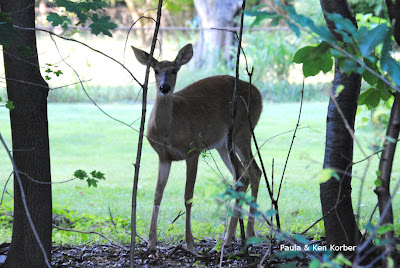What does a Suburban Wildlife Sanctuary Look Like?
 |
| Goldfinch in Purple Coneflowers |
Creating a wildlife habitat does not happen overnight, it takes time and patience. Starting small is a wise idea; pick a section of your: yard, park, school or business and reserve it for the "critters".
It is fun to research which native plants will perform best in the environment that you have chosen; there are numerous websites and books to assist you with this process.
In our previous post, Why Not A Butterfly Garden?, we mentioned that Ken and Paula Korber have been working for several years on developing a yard which is welcoming to: birds, bees, butterflies, skippers along with a host of other insects. I think you will be a bit surprised by some of their other garden guests.
"We have a thistle-feeder in the back for the Goldfinches.
Guess "fresh" tastes better."
Paula Korber
In our previous post, Why Not A Butterfly Garden?, we mentioned that Ken and Paula Korber have been working for several years on developing a yard which is welcoming to: birds, bees, butterflies, skippers along with a host of other insects. I think you will be a bit surprised by some of their other garden guests.
Who is on the Guest List?
By Paula Korber
 |
| Chipmunk waiting for sunflower seeds |
Chipmunks
The dirty look you're seeing is because I have a camera instead of the scoop of sunflower seed he was expecting.
We used to see a lot more squirrels. When our trees were removed, they relocated. They continue to visit our yard for food and water, but they are not as friendly or trusting as they used to be. Feel bad about that.
Cardinals
Male & Female Cardinals-mating pair, also expecting more sunflower seed instead of camera. The female is waiting on the woodpile for her mate to feed her. The male is closer to where we have the feeder hidden. If the male doesn't feed her fast enough, or consumes more than he's willing to share, she's not shy about hopping up and helping herself: Pretty sure he pays the for it later.

Male Cardinal

Female Cardinal
"The chipmunk and cardinals were given and extra scoop of
sunflower seed before I went back in doors."


"The chipmunk and cardinals were given and extra scoop of
sunflower seed before I went back in doors."
Paula Korber
Home is not Measured by its Size
 |
| Frog loving his home! |
Frogs
This is a very small pond in our backyard. Ken dug it out so the frogs would have somewhere to go once the creek dried up.
They start arriving early spring. They leave to bury themselves in mud when the weather starts truning colder.
They start arriving early spring. They leave to bury themselves in mud when the weather starts truning colder.
Deer
 |
| Two Fawns-Checking out the ladder previously being used for tree trimming. |
 |
| Mama deer looking for her young. She's a little late, they left after napping in the shade. |
The deer in these pictures have been displaced. Several wooded areas have been cleared to build houses since we bought here. There is no place for them to go.
Benefits of Near by Parks?
Large ponds in surrounding parks help explain some visitors. They are beautiful animals in a larger area where their food source have a reasonable chance of escape. Here, escape routes are limited to the small size of the pond, or the cover we've planted surrounding our yard. We feel some responsibility to limit predator visits to as little time as possible in the yard. Given our space, all it usually takes a window being opened or an occasional walk through the yard. By the way, there is nothing funnier than a heron awkwardly perched in a tree, waiting for you to leave!.

Nice photos of the animals in your garden. I too utilize a lot of native plants in my garden (though I'm in zone 7b). Half the fun of gardening is watching the wildlife that visits. We see deer, owls, hawks, hummingbirds and lots of butterflies, and all sorts of smaller wildlife. You can see some photos here: http://www.gardenexperiments.com/backyard-wildlife-the-critters-in-my-garden/
ReplyDeleteThank you for visiting our blog. It is nice to hear that you are planting natives. You are right it is not only rewarding but fun when you garden to attract wildlife. I love the title of your blog. Experiments are what keeps gardening exciting.
ReplyDelete